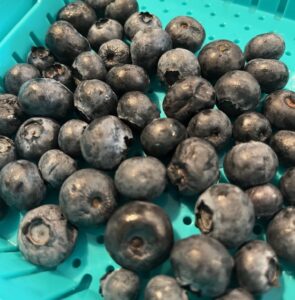“Is this healthy food?” “Is this unhealthy food?”
Lately, I’m noticing more interest around healthy food. On one hand, this excites me to no end. I love conversations about food, in general. And I especially love people taking a genuine interest in embracing food as an opportunity to fuel their body, fight diseases, and feel their best.
But, I think this interest on healthy is focused on the wrong concept. It’s also asking the wrong questions. What really should be the concern is nutrition. And the questions we should seek to understand: “Is this nutritious food?” “Does this support my nutritional needs and goals?”
Why focus on nutritious food
I’m really passionate about focusing food conversations, first, on nutritious food. I think people use the word “healthy” when they often mean nutritious, or use them interchangeably. But the two are different and worthy of their own categories.
Healthy food is incredibly subjective, in context and in the greater scheme of who we all are as unique people with unique health choices, lifestyles, and needs. I’ll get into that later.
The other, and perhaps larger reason I hope to see a shift in conversations towards nutritious over healthy, is there’s a lot of bad advice and inaccurate information out there on healthy eating. Restrictive diets, categorizing foods as “bad,” and failing to see the real point – nutrition is most important – is all unfortunate. I once saw an influencer bash berries and carrots – nutritional powerhouses – because they contain sugar. This is what we’re up against.

Fear no food – especially ones packed with nutrition.
I am here for none of that. Diet philosophy that preaches restrictions, rules, what you can’t eat, and what’s “bad” food is garbage. All it does is create more confusion and fear around food.
I’m also very concerned about the unbelievable reality we’re all witnessing, the pushing of semaglutides, i.e. GLP-1s like Ozempic and Wegovy.
I won’t get deep into that but I will say, one of my biggest concerns there and that relates to this conversation: we are not in need of less food. We’re in need of more nutritious food, quality food, the foods that fill and fuel us.
This is why I want to dive into the topic of nutritious food. My hope is to help simplify a topic that has become very complex and instill a sense of positivity around food.
Because food is here to nourish our bodies, fuel us to be our best, and is something to enjoy as we connect with others, celebrate occasions, and live each day!
What foods are nutritious foods?
I define nutritious food as food eaten with the purpose of nourishing your body with nutrients and other good things it needs to function at its best.
A seemingly simple question like, “Is this bread healthy?” does not have a simple answer. It lacks personalization. Healthy…for who? For me, the answer may be different than for you. It also lacks context. Healthy…like this wheat bread, compared to white bread?
A question like this, however, “Is this bread nutritious?” has a simpler answer. That’s because nutritious food is fairly non-subjective, especially when we’re talking micronutrients.
Nutrition conversations do get a little more complicated when talking about macronutrients: carbohydrates, fats, and protein. A few quick rules of thumb for those:
-Choose quality carbs, especially fiber and natural sugar – that’s right, sugar is not bad!
-Opt for natural sources of protein, like eggs, beans, spinach – real food sources over processed.
-Don’t skip healthy fats, like avocado and olive oil, real butter, and nuts – full-fat is not bad!
Because macros get complex, depending on so many personal health needs and lifestyle choices, I’ll focus more on micronutrients. These include vitamins and minerals, from the well-known calcium and iron to the quieter powerhouses like magnesium and potassium.
There’s also “nutrition” that comes from antioxidants and probiotics. Even water should be considered nutritious because of its power to naturally detoxify the body and keep it functioning at its best.
I’m so passionate about nutritious food because of all the benefits the right balance of nutrients can bring. When eaten regularly, nutritious foods can prevent, even reverse chronic diseases, tame inflammation, keep your gut healthy – which can also keep your brain healthy, because of how linked the gut and brain are in the body – and fuel you with energy and focus.
And, because it has to be said, a nutritious balance of foods will naturally help manage weight. No judgment because we all do this – but think about how easy it is to eat half a bag of chips or pint of ice cream and not even feel full. Now think about eating 3 bananas, a head of cauliflower, or an entire bag of spinach. I feel full just reading that.
How to choose nutritious foods
All that said – how do you know what’s nutritious food? On the most basic level, much of our nutrition comes from the foods you probably already think of as “healthy” like berries and sweet potatoes, fish and eggs, beans and seeds, oats and quinoa. There are also powerful spices like cinnamon, garlic, and turmeric that have nutritional and whole-body benefits.

Cooking at home is one of the best ways to ensure you’re eating nutritious food
Outside of those more obvious, and because no food is off-limits, it’s important to learn how to read labels on anything packaged. Notice how many ingredients are in something – some you may not recognize and that’s okay! Just start being more aware and pausing to look.
Building on the idea of inclusive eating and enjoying a variety of foods, not every food you eat has to be a direct source of nutrition. Some can be, as I like to think of it, vehicles for creating nutrition.
Let’s go back to bread. I’m sad how it’s been vilified because bread isn’t bad. It’s not fair to call it “unhealthy” and just leave it at that.
Instead, let’s ask the right question and take it a step further: Is it nutritious? Not really, no – but a sandwich can be. Add cheese and pile on the veggies to basic bread, boom. Or, top a slice with fried egg, roasted tomatoes, and avocado. Nutritious and delicious!
On the flip side, if asked “Is salad healthy?” most people would say yes! The nutritional truth is a lot of lettuce varieties don’t offer much of it and store-bought salad dressings are often loaded with sugar and excess ingredients, not nutrition. However, a salad can be super nutritious. Mix spinach with the lettuce, add a ton of veggies, sprinkle in some quinoa and cheese, and toss in chicken or beans for a protein boost. You can make a delish salad dressing with ranch seasoning, a little mayonnaise, and Greek yogurt – and the yogurt will give you bonus probiotics for good gut health!
Start to build your own nutritious eating habits by finding reputable outlets (not influencers) to do your research. Begin checking labels. Cook as many whole, unprocessed foods as you can.
And be mindful to learn what you really need out of your food and what works best for those needs. A woman in her late 40s has different nutritional priorities than a man in his early 20s. Both need nutrition – but one may be more interested in a combination that supports peri-menopause symptoms while the other may seek more carbs and iron.
These steps add up to a great recipe for more nutritious eating. Bonus, nutritious food fills you up and gives your body what it needs, unlike ultra-processed food that offers no nutritional value and leaves you hungry for more. You don’t need a diet pill, you need nutrition.
What foods are healthy foods?
Okay, okay – I’m not against the idea of healthy food. I love health and wellness, across the board, in general. So allow me to explain why it’s different than nutritious food.

Enjoying a donut – with a friend – while running a 5k – feels very healthy to me!
I define healthy food as food eaten with a purpose to fuel your body, mind, or, in some cases, happiness.
Healthy food seems like it would be an easy concept but it’s more confusing than nutritious food, because things get really subjective and can be even more personal than nutrition.
Back to the bread. I’m a fan of bread. As an endurance athlete, one of my favorite pre-run breakfasts is toast with peanut butter and a banana. It gives me great fuel to tackle marathon-distance miles, while sitting well in my stomach. So, is bread healthy? In this scenario, absolutely yes.
For someone who’s not as active or needs to closely manage their blood sugar, that may not be the best breakfast to optimize their health. So the answer to, “Is this food healthy?” is really different from one person to another, even one scenario to another.
A final note about healthy food. Perhaps the trickiest thing about choosing healthy foods, whether in a grocery store or even when out to eat, is marketing. Organic, gluten-free, fat-free – these words do not equal healthy. Food has been cleverly marketed for years to make us believe things are healthy or at least healthier than a similar option. But all those words are is marketing (unless, in this example, you have Celiac Disease).
People are probably sick of hearing this but it really boils down to balance. Mostly nutritious foods most of the time leaves plenty of room for other foods and give an overall sense of balance.
If you’re trying to improve your health and wellness, and are looking harder at your food as a way to do it, big high-fives. I may say that it’s simple – but please know that I do not think it’s easy. Eating a nutritious, balanced diet is really hard. I hope this gives you a better sense of how to get started and helps along the way.
That’s enough for now. Until next time,
Lindsay
